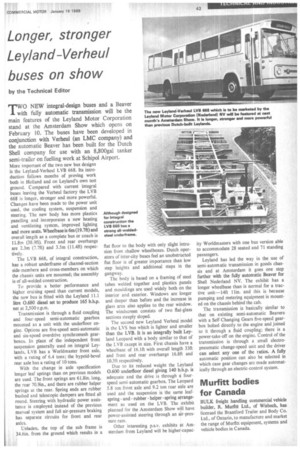Longer, stronger Leyland-Verheul buses on show
Page 45

If you've noticed an error in this article please click here to report it so we can fix it.
by the Technical Editor
TWO NEW integral-design buses and a Beaver with fully automatic transmission will be the main features of the Leyland Motor Corporation stand at the Amsterdam Show which opens on February 10. The buses have been developed in conjunction with Verheul (an LMC company) and the automatic Beaver has been built for the Dutch Shell company for use with an 8,800gal tanker semi-trailer on fuelling work at Schipol Airport.
More important of the two new bus designs is the Leyland-Verheul LVB 668. Its introduction follows months of proving work both in Holland and on Leyland's own test ground. Compared with current integral buses leaving the Verheul factory the LVB 668 is longer, stronger and more powerful. Changes have been made to the power unit used, the cooling system, suspension and steering. The new body has more plastics panelling and incorporates a new heating and ventilating system, improved lighting and more seats. Wheelbase is 6m (19.7ft) and overall length as a complete bus or coach is 11.8m (38.9ft). Front and rear overhangs are 2.3m (7.7ft) and 3.5m (11.4ft) respectively.
The LVB 668, of integral construction, has a robust underframe of channel-section side-members and cross-members on which the chassis units are mounted; the assembly is of all-welded construction.
To provide a better performance and higher cruising speed than current models, the new bus is fitted with the Leyland 11.1 litre 0.680 diesel set to produce 165 b.h.p. net at 2,500 r.p.m.
Transmission is through a fluid coupling and four-speed semi-automatic gearbox mounted as a unit with the underfloor engine. Options are five-speed semi-automatic and six-speed overdrive synchromesh gearboxes. In place of the independent front suspension generally used on integral Leylands, LVB has a Worldmaster front axle, with a rating of 6.4 tons; the hypoid-bevel rear axle has a rating of 10 tons.
With the change in axle specification longer leaf springs than on previous models are used. The front springs are 61.8in. long, the rear 70.9in., and there are rubber helper springs at the rear. Spring ends are rubber bushed and telescopic dampers are fitted all round. Steering with hydraulic power assistance is employed instead of the previous manual system and full air-pressure braking has separate circuits for front and rear axles.
Unladen, the top of the sub frame is 34.6in. from the ground which results in a flat floor to the body with only slight intrusion from shallow wheelboxes. Dutch operators of inter-city buses feel an unobstructed flat floor is of greater importance than low step heights and additional steps in the gangway.
The body is based on a framing of steel tubes welded together and plastics panels and mouldings are used widely both on the interior and exterior. Windows are longer and deeper than before and the increase in glass area also applies to the rear window. The windscreen consists of two flat-glass sections steeply sloped.
The second new Leyland Verheul model is the LVS bus which is lighter and smaller than the LVB. It is an integrally built Leyland Leopard with a body similar to that of the LVB except in size. First chassis have a wheelbase of 16.1ft with overall length 33ft and front and rear overhangs 16.8ft and 10.3ft respectively.
Due to its reduced weight the Leyland 0.600 underfloor diesel giving 140 b.h.p. is adequate and the drive is through a fourspeed semi-automatic gearbox. The Leopard 5.8 ton front axle and 9.2 ton rear axle are used and the suspension is the same leafspring and rubber helper -spring arrangement as used on the LYE. The exhibit planned lor the Amsterdam Show will have power-assisted steering through an air-pressure ram.
Other interesting p.s.v. exhibits at Amsterdam from Leyland will be higher-capac ity Worldm asters with one bus version able to accommodate 28 seated and 71 standing passengers.
Leyland has led the way in the use of semi-automatic transmission in goods chassis and at Amsterdam it goes one step further with the fully automatic Beaver for Shell Nederland NV. The exhibit has a longer wheelbase than is normal for a tractive unit-14ft 11M. and this is because pumping and metering equipment is mounted on the chassis behind the cab.
The transmission is basically similar to that on existing semi-automatic Beavers with a Self-Changing Gears five-speed gearbox bolted directly to the engine and joined to it through a fluid coupling; there is a power-take-off on the engine. Control of the transmission is through a small electropneumatic change-speed unit and the driver can select any one of the ratios. A fully automatic position can also be selected in which case gear changes arc made automatically through an electric-control system.
Murat bodies for Canada
BULK freight handling commercial vehicle builder, R. Murfitt Ltd., of Wisbech, has licensed the Brantford Trailer and Body Co. Ltd., of Ontario, to manufacture and market the range of Murfitt equipment, systems and vehicle bodies in Canada.




















































































































